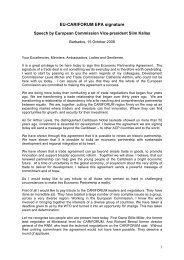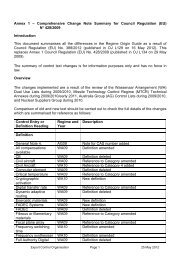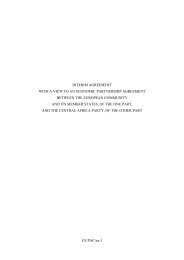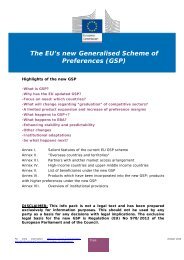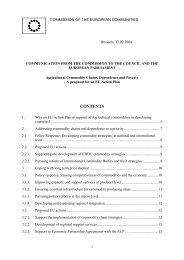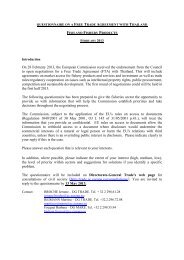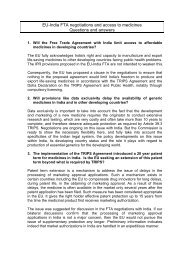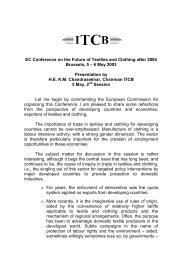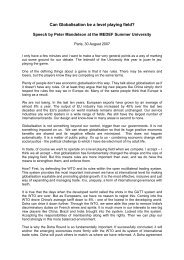Report on the Implementation of the derogation to ... - Trade Websites
Report on the Implementation of the derogation to ... - Trade Websites
Report on the Implementation of the derogation to ... - Trade Websites
Create successful ePaper yourself
Turn your PDF publications into a flip-book with our unique Google optimized e-Paper software.
Final <str<strong>on</strong>g>Report</str<strong>on</strong>g><br />
RoO Derogati<strong>on</strong> under <strong>the</strong> PACP-IEPA<br />
facilities, given producti<strong>on</strong> levels have generally remained c<strong>on</strong>stant and well below capacity. To<br />
date, existing plants have generally been able <strong>to</strong> meet raw material needs with EU-compliant<br />
catches from <strong>the</strong>ir own fleets, or if sourcing from n<strong>on</strong>-company vessels, are yet <strong>to</strong> branch out and<br />
utilise <strong>the</strong> RoO derogati<strong>on</strong> <strong>to</strong> its full capacity <strong>to</strong> source fish from vessels who have not traditi<strong>on</strong>ally<br />
supplied <strong>the</strong>m in <strong>the</strong> past.<br />
There are currently five new planned tuna processing investments for PNG, each at different stages<br />
<strong>of</strong> development; four at Malahang Industrial Estate, Lae and <strong>on</strong>e at <strong>the</strong> Pacific Marine Industrial<br />
Z<strong>on</strong>e at Vidar, Madang. By 2016, estimated <strong>to</strong>tal daily producti<strong>on</strong> could potentially reach around<br />
730 mt/day (~182,500 mt raw material), should all five new and proposed operati<strong>on</strong>s proceed. At<br />
present, <strong>the</strong>re are few o<strong>the</strong>r c<strong>on</strong>firmed additi<strong>on</strong>al projects in <strong>the</strong> pipeline for tuna processing in<br />
PNG, and <strong>the</strong> publicity given <strong>to</strong> <strong>the</strong> possibility <strong>of</strong> rapid large scale expansi<strong>on</strong> seems not be based <strong>on</strong><br />
<strong>the</strong> reality <strong>of</strong> existing development plans.<br />
Expansi<strong>on</strong> is currently driven largely by PNG’s Nati<strong>on</strong>al Fisheries Authority (NFA) policy <strong>of</strong> linking<br />
fisheries access <strong>to</strong> <strong>on</strong>shore processing, ra<strong>the</strong>r than duty free access <strong>to</strong> <strong>the</strong> EU market and global<br />
sourcing per se. However, while not <strong>the</strong> primary driver for attracting <strong>on</strong>shore investment, <strong>the</strong><br />
derogati<strong>on</strong> will play a critical role in industry expansi<strong>on</strong> in <strong>the</strong> future and its survival. One <strong>of</strong> <strong>the</strong><br />
primary intenti<strong>on</strong>s <strong>of</strong> negotiating global sourcing was <strong>to</strong> reduce <strong>the</strong> impediment <strong>to</strong> industry<br />
expansi<strong>on</strong> <strong>of</strong> inadequate supplies <strong>of</strong> wholly originating fish for export <strong>to</strong> <strong>the</strong> EU market. Global<br />
sourcing, am<strong>on</strong>gst o<strong>the</strong>r fac<strong>to</strong>rs, will assist in efforts <strong>to</strong> achieve greater ec<strong>on</strong>omies <strong>of</strong> scale, such that<br />
PNG tuna processing facilities can improve <strong>the</strong>ir competitiveness in <strong>the</strong> short-medium term. In<br />
doing so, if and when PNG’s margin <strong>of</strong> preference (24%) <strong>to</strong> <strong>the</strong> EU gradually erodes in light <strong>of</strong> more<br />
favourable trade preferences garnered by PNG’s major competi<strong>to</strong>rs (e.g. Thailand, Philippines),<br />
global sourcing will be a c<strong>on</strong>tributing fac<strong>to</strong>r in sustaining PNG’s processing sec<strong>to</strong>r in <strong>the</strong> future.<br />
Income generati<strong>on</strong><br />
For 2007-2010, <strong>to</strong>tal direct income generated <strong>to</strong> <strong>the</strong> PNG ec<strong>on</strong>omy by <strong>the</strong> existing three tuna<br />
processing facilities was in <strong>the</strong> order <strong>of</strong> around K 35 milli<strong>on</strong> – K 48 milli<strong>on</strong> annually (US $16 - 22<br />
milli<strong>on</strong>). The most significant c<strong>on</strong>tributi<strong>on</strong>s <strong>to</strong> <strong>the</strong> ec<strong>on</strong>omy were employee earnings (average K 25<br />
milli<strong>on</strong>/year; 45% <strong>of</strong> net income) and net purchases in local businesses (average K 13.5 milli<strong>on</strong>/year;<br />
32% <strong>of</strong> net income).<br />
Since 2007, <strong>the</strong> <strong>to</strong>tal net direct income generated from canned tuna and tuna loin processing has<br />
generally increased, however, this cannot be directly linked with global sourcing. This trend relates<br />
largely <strong>to</strong> increased c<strong>on</strong>tributi<strong>on</strong>s from <strong>on</strong>e <strong>of</strong> <strong>the</strong> three existing canneries, whose producti<strong>on</strong> has<br />
expanded annually since establishment in 2006. Also, employee earnings have increased<br />
c<strong>on</strong>sistently in line with increases in <strong>the</strong> minimum wage rate.<br />
In <strong>the</strong> medium term, as new <strong>on</strong>shore investments come <strong>on</strong> stream, additi<strong>on</strong>al income will be<br />
generated in <strong>the</strong> ec<strong>on</strong>omy - <strong>the</strong> largest direct c<strong>on</strong>tributi<strong>on</strong>s being employment earnings and<br />
spending by canneries (and <strong>the</strong>ir employees) in local businesses.<br />
Employment<br />
New tuna processing facilities will generate a significant increase in employment opportunities for<br />
PNG nati<strong>on</strong>als, particularly young women (potentially in <strong>the</strong> order <strong>of</strong> 50,000 direct and indirect jobs<br />
by 2016).<br />
Linpico s.a.r.l. Page 2




